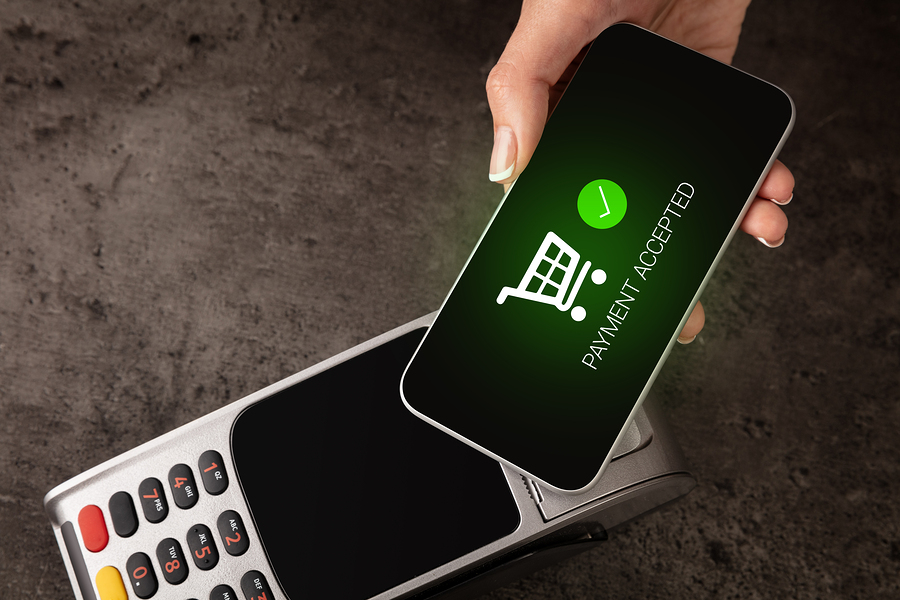Understanding How To Leverage This Vital Tool For Your Business
“Merchant services”, “bank merchant”, “credit card processing”, “bank acquiring”, “payment processing”, “digital payments”…
No matter what you call it, being able to accept electronic, online, and now mobile payments has become more vital than ever to sustain virtually any business.
I’ve mentioned before that this isn’t exactly a “sexy” topic, but that doesn’t mean it’s any less important. Why? Because the world has rapidly shifted to a digital economy. This means consumers are demanding the ability to pay without coming into direct contact with you and your staff.
ATM usage is down around 17.8% YOY compared to 2019, and The Fed has even revised the way they release coins, making it hard to find adequate change at retail shops. It’s a brave new world, and as the old saying goes, “It’s not personal, it’s just business.”
So, let’s explore how digital payments work, and how you can leverage them to grow your business during this massive Digital Shift, because Knowledge really is power.
Why Are Digital Payments So Confusing?

It’s no secret that the electronic payments industry, also called Merchant Services, is clouded in mystery. Between the vast number of players involved, the countless fees, and thousands of other variables, it can be a lot to handle.
Let’s “geek out” for a minute though and look at the three main reasons electronic payments are so complicated. Don’t worry, we won’t get lost in a lot of techno-babble. This is just an overview of the three main reasons why electronic payments are so complicated:
1. The numerous organizations involved
2. The endless fees that can apply to any transaction
3. Confusion = ability to charge more
Let’s look at each of these, and how they apply.
1. The numerous parties involved:
To give you an idea of why ePayments are inherently confusing, let’s first look at how any ePayment gets processed. Whether a consumer swipes a card at the counter or clicks to pay on a website, the process is pretty much the same. The only difference is the layers of security used at the point of sale versus on a website.
When a customer is ready to buy, they enter their card information by either inserting their card into a terminal or entering it into a checkout page. Those payment credentials are then sent through a series of institutions that make up the credit card financial network. This includes payment gateways, merchant acquirers, the card brands, banks, and card Issuers. All of these organizations work together to authorize the transaction, assess the fees, and complete the process.
Once a payment is approved, the customer is given a receipt, and the funds are moved to the business’ account, typically in 1-2 business days.
Here’s a “simple” visual diagram:

At the end of the month, the organization that accepted the electronic payments is assessed a series of fees, the largest being what’s called a “discount rate”.
A discount rate is the percentage a business is charged for the “privilege” of being able to accept credit cards as a form of payment.
That’s right, I said privilege. The word discount is derived from the fact that you’ll now be selling your goods and services for less than if you accepted cash or check as payment. Welcome to the club!
Another term for this is “Interchange Fees”. An Interchange Fee usually includes both a % you’ll pay, plus a flat, per-transaction fee. This typically looks like a fee of 3.0% + $0.20 to process a payment.
Of course, this is an extreme over-simplification of how ePayments work, but it is an accurate overview behind the scenes.
What I really want you to take away from this is the number of layers it takes to get a simple payment processed. All of these organizations (layers) add complexity and costs. At the end of the day these costs are built into the costs (discount) you pay.
Speaking of costs, let’s take a brief overview of them to see what’s involved…The endless fees that can apply to each payment:
Now, let’s look at the fees that can apply to each transaction. At the time of writing this book, there were over three hundred (300) different discount rates that can be applied to any credit card payment. Yes, 300! Again, the discount rate is how much your business pays for the privilege of being able to accept credit cards.
Why so many rates? Mainly because there’s a different rate assessed for each type of card used for payment. For example, debit cards are the cheapest because they’re essentially the same as your customer writing a paper check. The funds are debited directly from their bank account, and there’s no credit needed. This is also why grocery stores and gas stations ask you multiple times if you’re paying with a debit card. It’s annoying, but they’re trying to keep their fees as low as possible.
In contrast to debit cards, business rewards credit cards are the most expensive to accept. Let’s take a look at just how different the costs are to accept a $100 payment for a debit card versus a business rewards credit card.
Option 1 – Accepting Debit Cards
Currently, certain debit cards offer a discount rate as low as 0.05% + $0.22. So, if a customer pays a $100 invoice using their debit card, you can expect a fee of $0.27, and will receive $99.78 in the bank.
Not bad, right? Twenty-seven cents to automate how you get paid is a great deal. Sign me up!
However…
Option 2 – Accepting Business Rewards Cards
If that same customer pays their $100 invoice with a business rewards card that offers a 2% cash back reward. Put on a diaper and get ready for this…
The rate your business will now pay for the very same transaction skyrockets.
Typical Debit card payments cost:
0.05% + $0.22
Typical Credit card payments costs:
2.80% + $0.20.
This means for the exact same transaction your fee will be $3.00 compared to the 27-cents.
That’s an 1,100% increase in your cost to process the EXACT SAME $100 TRANSACTION!
In the payments industry, a higher discount rate is known as a “Downgrade”. The rate you pay is higher for these types of cards, so the rate gets downgraded (that’s code for a much higher cost for your business).
Why? Remember how I mentioned that this card earns the customer a 2% cash back rewards? Guess who gets to pay for that reward? YOU!
Let’s recap that. When a consumer uses any rewards card to pay, your costs go up to pay for that reward so they’ll use this card over the others cards in their wallet. (Fun Fact: The average American has six credit cards in their wallet. How many do you have?)
To pay for those rewards, you get charged more. Not a trivial amount either – 1,100% more.
Ouch!
So, at the end of the day you’re footing a good chunk of the bill for all these rewards programs being offered. Crazy, right?
Don’t be fooled by the gimmicks merchant account providers use to “hide” these costs either. A popular one used is offering you a flat rate for all transactions, like 2.90% + $0.30 per transaction.
First off, that’s not even true, because that “lower rate” is for swiped transactions that only occur when someone is standing in front of you. All others see a rate increases to around 3.5% + $0.40.
Of course, a flat rate also means you’re paying 1,100% more for all debit card transactions.
So…what can you do?
Well, there are really three options you can pursue:
Option 1. Do nothing.
Doing nothing is always an option no matter what anyone says. If the fees you’re paying aren’t that high then don’t worry about it.
However, I would strongly suggest setting an annual reminder to review what you’re paying.
Keep in mind, if your business operates on a 10% margin, paying a 3% fee on any transaction will equal 30% of your gross profit. That’s not pocket change, and we’ll cover this in more detail soon.
Option 2. Assess how much credit cards are or will cost you.
I’ve seen rates as low as 1.5% in our clients’ businesses, and sometimes as high as 16% of total revenue. If you’re ok giving up as much as 16% of your hard-earned $$ then more power to you.
[Note: To calculate your true merchant service costs, divide your total net sales by the total fees paid.]
Option 3. Use a trusted payment technology partner that helps you legally and ethically overcome these expenses.
There are solutions that can help you eliminate the costs associated with accepting digital payments, but they’re not all created equally. Be sure to get to know them before signing anything.
Find out how long they’ve been in business, and who’s using them. There’s a lot at stake here, so be sure to proceed with confidence. The most trusted name in the business since 2005 is Xpress-pay.
Remember how I mentioned that the merchant services industry is inherently confusing, which helps providers increase costs for folks like you? Why is that you ask? Well, to put it simply…
Confusion = Ability to Charge More
Over the last few years, running an eCommerce site has gotten considerably more expensive AND confusing. That’s no coincidence.
Business owners are busy, and whether your company’s doors just opened, or you’ve been in business for 50 years, your time is at a premium. If you get a merchant account statement that’s written in Sanskrit, chances are it’s going to get tossed aside.
Merchant service providers know this and have used it for years to tack on all sorts of one-time fees. I’ve personally seen them add fees for things like “PCI compliance”, “Tax Preparation”, and many other completely frivolous reasons. They’re only there to pad their profits, so be sure to be on the lookout for what we call “rate creep.” Over time, the amount you pay to process credit cards can add up to astronomical rates.
I can’t tell you how many clients we’ve shown what they thought they were paying, versus what they actually pay and their jaws hit the floor. I mention this so you are aware that the practice does exist, and will be vigilant against it.
Look at your statements often to be sure the fees are in-line with expectations. If they’re higher than they should be, contact your sales rep immediately. If they’re not willing or able to help, don’t be afraid to start shopping around for a new provider. It’s just good practice. Be aware though, as most merchant account agreements carry a 3-year, early termination fee.
So, how do you leverage digital payments to grow your business?
For more information on how to conquer everything we discussed, head here.

